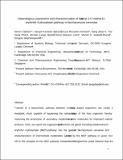Heterologous expression and characterization of bacterial 2-C-methyl-d-erythritol-4-phosphate pathway in Saccharomyces cerevisiae
Author(s)
Formenti, Luca Riccardo; Phon, Too Heng; Nielsen, Michael Lynge; Lantz, Anna Eliasson; Kielland-Brandt, Morten C.; Carlsen, Simon; Zhou, Kang; Stephanopoulos, Gregory; Parayil Kumaran, Ajikumar; ... Show more Show less
Download253_2013_4877_ReferencePDF.pdf (5.627Mb)
OPEN_ACCESS_POLICY
Open Access Policy
Creative Commons Attribution-Noncommercial-Share Alike
Terms of use
Metadata
Show full item recordAbstract
Transfer of a biosynthetic pathway between evolutionary distant organisms can create a metabolic shunt capable of bypassing the native regulation of the host organism, hereby improving the production of secondary metabolite precursor molecules for important natural products. Here, we report the engineering of Escherichia coli genes encoding the 2-C-methyl-d-erythritol-4-phosphate (MEP) pathway into the genome of Saccharomyces cerevisiae and the characterization of intermediate metabolites synthesized by the MEP pathway in yeast. Our UPLC-MS analysis of the MEP pathway metabolites from engineered yeast showed that the pathway is active until the synthesis of 2-C-methyl-d-erythritol-2,4-cyclodiphosphate, but appears to lack functionality of the last two steps of the MEP pathway, catalyzed by the [4Fe–4S] iron sulfur cluster proteins encoded by ispG and ispH. In order to functionalize the last two steps of the MEP pathway, we co-expressed the genes for the E. coli iron sulfur cluster (ISC) assembly machinery. By deleting ERG13, thereby incapacitating the mevalonate pathway, in conjunction with labeling experiments with U–[superscript 13]C[subscript 6] glucose and growth experiments, we found that the ISC assembly machinery was unable to functionalize ispG and ispH. However, we have found that leuC and leuD, encoding the heterodimeric iron–sulfur cluster protein, isopropylmalate isomerase, can complement the S. cerevisiae leu1 auxotrophy. To our knowledge, this is the first time a bacterial iron–sulfur cluster protein has been functionally expressed in the cytosol of S. cerevisiae under aerobic conditions and shows that S. cerevisiae has the capability to functionally express at least some bacterial iron–sulfur cluster proteins in its cytosol.
Date issued
2013-05Department
Massachusetts Institute of Technology. Department of Chemical EngineeringJournal
Applied Microbiology and Biotechnology
Publisher
Springer-Verlag
Citation
Carlsen, Simon, Parayil Kumaran Ajikumar, Luca Riccardo Formenti, Kang Zhou, Too Heng Phon, Michael Lynge Nielsen, Anna Eliasson Lantz, Morten C. Kielland-Brandt, and Gregory Stephanopoulos. “Heterologous Expression and Characterization of Bacterial 2-C-Methyl-d-Erythritol-4-Phosphate Pathway in Saccharomyces Cerevisiae.” Applied Microbiology and Biotechnology 97, no. 13 (May 1, 2013): 5753–5769.
Version: Author's final manuscript
ISSN
0175-7598
1432-0614